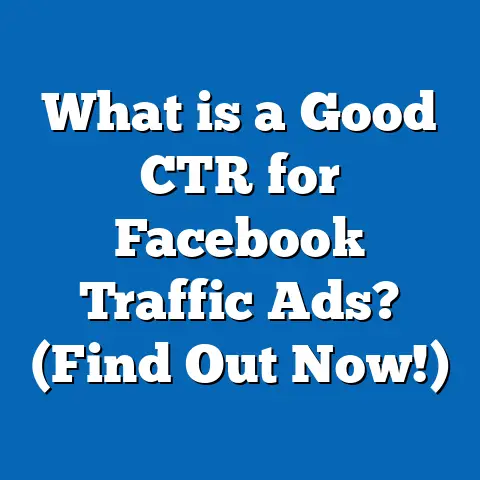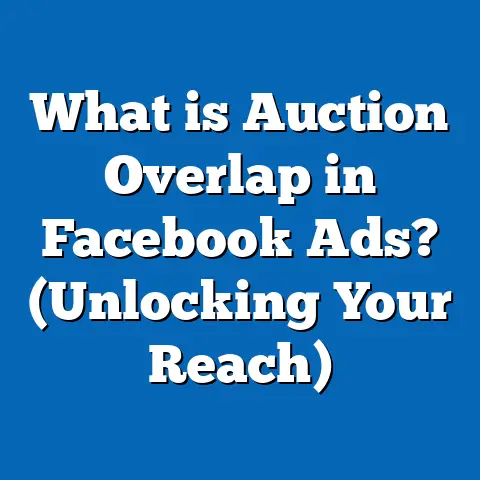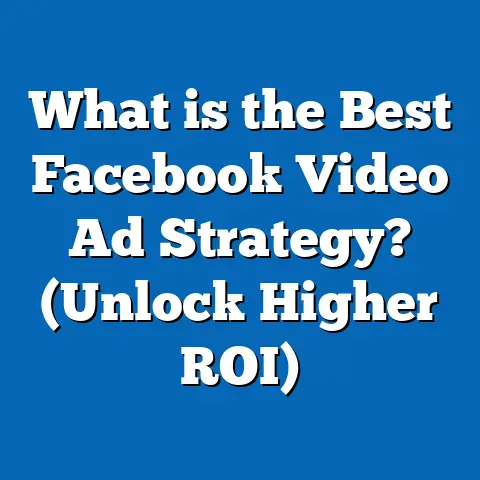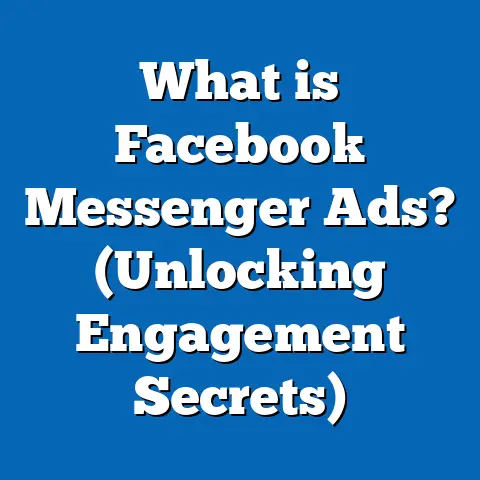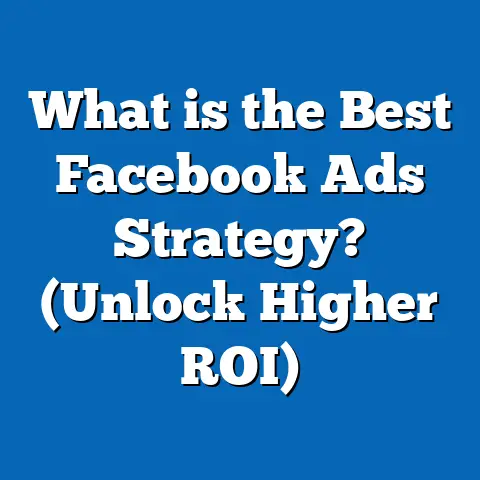What is Awareness in Facebook Ads? (Unlock Campaign Success)
What is Awareness in Facebook Ads? (Unlock Campaign Success)
Introduction: The Weather of Advertising
Imagine planning a weekend outing. You check the weather forecast first because it guides your decisions—whether to carry an umbrella, wear a jacket, or plan a picnic. The weather sets the tone for your day. Similarly, in digital marketing, understanding awareness in Facebook ads is like checking the advertising weather. It sets the stage for your entire campaign strategy.
Without clear awareness of who your target audience is and whether they know your brand, your marketing efforts can be wasted on uninterested people or lost in the digital noise. Awareness campaigns help you reach the right people and plant the seed for future engagement and conversion. They are the first touchpoint that influences how customers perceive your brand.
This guide will explain everything you need to know about awareness in Facebook ads—from basics to advanced strategies—backed by data, case studies, and actionable insights.
Section 1: What Is Awareness in Facebook Ads?
Defining Awareness in Advertising
In marketing terms, awareness means how familiar potential customers are with a brand or product. It’s about making sure people know you exist.
For Facebook ads, awareness refers to campaigns designed to introduce your brand or product to a broad or targeted audience with the goal of increasing recognition and recall.
Awareness vs. Other Marketing Objectives
Facebook structures its ad campaigns under different objectives:
- Awareness (Brand Awareness, Reach)
- Consideration (Traffic, Engagement, App Installs, Video Views, Lead Generation)
- Conversion (Sales, Leads, Store Visits)
Awareness is at the very beginning of this funnel. It’s different from conversion because it doesn’t focus on immediate sales or sign-ups but on creating familiarity.
Why Awareness Matters More Than Ever
Digital space is crowded. According to DataReportal, as of 2024 there are over 4 billion active social media users worldwide. Your audience sees hundreds of ads daily across platforms.
Without awareness, your future campaigns for engagement or sales lose impact because people don’t recognize your brand or trust it enough to act.
Section 2: Facebook’s Awareness Campaign Objectives Explained
Facebook offers two main campaign objectives that focus on awareness:
Brand Awareness Objective
This objective targets people who are most likely to remember your ad.
- It optimizes delivery toward users predicted to recall the ad.
- Facebook uses machine learning to identify users with high ad recall potential.
- Performance is measured by Estimated Ad Recall Lift (EARL) — an estimate of how many people will remember seeing your ad within 2 days.
When to Use Brand Awareness Objective
- Launching a new product or service.
- Entering new markets.
- Rebranding or repositioning.
- Building long-term brand equity.
Reach Objective
Reach campaigns aim to maximize the number of unique people who see your ads.
- Reach counts unique individuals exposed to your ad at least once.
- Can control frequency (how many times an individual sees the ad).
- Useful for broad exposure and mass-market promotions.
When to Use Reach Objective
- Time-sensitive events like sales or product launches.
- Local business promotions targeting specific geographic areas.
- Increasing visibility during brand campaigns.
Section 3: How Facebook Measures Awareness
Estimated Ad Recall Lift (EARL)
Facebook developed EARL to answer: How many people are likely to remember this ad?
It’s calculated by comparing a test group exposed to your ad versus a control group not exposed. This scientific approach helps advertisers understand which ads are memorable beyond just clicks and impressions.
Reach and Frequency Metrics
- Reach: Number of unique people who saw your ad.
- Frequency: Average times each person saw the ad.
Balancing reach and frequency is key. Too low frequency can mean weak recall; too high can cause ad fatigue.
Other Metrics Indirectly Linked to Awareness
- Impressions: Total number of times your ad is shown.
- Engagement: Likes, shares, comments indicating interest.
- Video Views: For video ads, shows how many watched part or all of your content.
Section 4: The Psychology Behind Awareness
How Brand Awareness Influences Consumer Behavior
Studies show consumers go through stages before purchase:
- Awareness: Knowing your brand exists.
- Consideration: Evaluating options.
- Preference: Favoring your brand.
- Purchase: Buying your product/service.
- Loyalty: Repeat purchases and advocacy.
Awareness is critical because if customers don’t know you exist, they can’t move down the funnel.
The Mere Exposure Effect
Psychological research identifies the mere exposure effect, meaning repeated exposure to a brand increases liking and trust subconsciously.
Facebook awareness campaigns use this by controlling frequency to create familiarity without causing annoyance.
Section 5: Data & Statistics on Awareness Campaigns
Here are some important data points that demonstrate the power of awareness campaigns:
| Statistic | Source/Context |
|---|---|
| Brands with high awareness spend generate up to 35% more brand recall | Facebook Internal Data |
| Consumers need 6-8 brand exposures before taking action | Marketing Science Institute |
| Video ads increase brand recall by up to 47% compared to static ads | Nielsen Study |
| Awareness campaigns have an average CPM between $5-$15 | WordStream Benchmark Reports |
| Mobile users spend over 2 hours daily on social media apps including Facebook | DataReportal |
This data highlights that investing in awareness yields measurable benefits in recall and sets up future conversion opportunities.
Section 6: How To Build Effective Awareness Campaigns on Facebook
Step 1: Define Your Target Audience
You must know who you want to reach:
- Use Facebook Audience Insights for demographics, interests, location.
- Segment audiences by behavior (e.g., frequent online shoppers).
- Create Lookalike Audiences from existing customers to find new prospects similar to them.
Step 2: Create Strong Creative Assets
Your creative drives attention and recall:
- Use vibrant images or videos with clear branding.
- Keep messaging simple and focused on emotional appeal rather than sales pitch.
- Consistent brand colors and logos improve recognition.
Step 3: Choose the Right Campaign Objective
Pick between Brand Awareness or Reach based on goals:
- Brand Awareness if you want measurable recall lift.
- Reach if you want maximum unique exposure.
Step 4: Set Budget & Bidding Strategy
Awareness campaigns typically use CPM bidding:
- Start with a daily budget aligned with audience size.
- Monitor CPM and adjust bids for cost efficiency.
Step 5: Optimize for Frequency
Ideal frequency varies but aim for 2-4 exposures per user over campaign duration to balance recall and avoid fatigue.
Section 7: Creative Best Practices for Awareness Ads
Use Video Content
Data shows video generates 6x more engagement than images:
- Keep videos short (15 seconds or less).
- Tell a story rather than pushing products directly.
- Include captions since many watch without sound.
Leverage Carousel & Collection Ads
These allow showcasing multiple products or features within one ad unit for richer storytelling.
Make Use of Facebook Stories Ads
Stories are full-screen vertical formats that feel immersive and authentic:
- Popular among younger demographics.
- High engagement due to placement above news feed.
Experiment with User-Generated Content (UGC)
People trust peers more than brands:
- Feature testimonials or customer reviews in ads.
- Encourage customers to share content using branded hashtags.
Section 8: Case Studies Highlighting Awareness Campaign Success
Case Study 1: Fitness Apparel Brand Launching New Line
Challenge: Introducing a new sustainable fitness apparel line in a crowded market.
Solution: Used Brand Awareness campaigns targeting environmentally conscious millennials with video ads showcasing product benefits and eco-friendly materials.
Results:
- Estimated Ad Recall Lift increased by 38%.
- Website visits from campaign grew by 30%.
- Subsequent conversion campaigns saw a 20% higher CTR than previous launches without awareness focus.
Case Study 2: Regional Restaurant Chain Promoting Grand Opening
Challenge: Attract local customers for new location grand opening.
Solution: Applied Reach campaigns targeting a 10-mile radius using bright imagery and event countdowns.
Results:
- Reached 150,000 unique users in two weeks.
- Achieved frequency of 3.2 times per user ensuring sufficient exposure.
- Foot traffic increased by 25% during opening week compared to previous openings without ads.
Section 9: Comparing Facebook Awareness Ads with Other Platforms
| Feature | Facebook Ads | Google Display Network | LinkedIn Ads |
|---|---|---|---|
| Targeting | Detailed demographic & behavioral | Contextual & keyword-based | Professional & B2B-focused |
| Ad Formats | Video, images, carousels, stories | Banner ads & video | Sponsored content & InMail |
| Audience Size | Over 2 billion monthly active users | Large global reach | Smaller but niche professional audience |
| CPM Range | $5 – $15 | $2 – $10 | $10 – $40 |
| Measurement | Estimated Ad Recall Lift | Viewability & impression metrics | Engagement & lead gen |
Facebook excels at consumer-focused awareness due to its rich targeting options and engaging formats. LinkedIn suits B2B awareness better but at higher costs.
Section 10: Advanced Strategies for Mastering Awareness Campaigns
Layering Audiences for Precision Targeting
Combine Custom Audiences (e.g., past website visitors) with Lookalikes for layered targeting that maximizes relevance while expanding reach.
Geo-Fencing for Local Business Awareness
Use location targeting combined with time-based scheduling (e.g., lunch hour ads for restaurants) to boost local foot traffic awareness efficiently.
Sequential Messaging Strategy
Start with broad awareness ads then retarget those who engaged with tailored consideration or conversion messages creating a funnel effect.
Dynamic Creative Testing
Let Facebook automatically test multiple creative combinations (images, headlines, text) to discover best-performing ads and optimize budget allocation accordingly.
Section 11: Common Challenges and How to Overcome Them
| Challenge | Solution |
|---|---|
| Low Brand Recall | Improve creative quality; increase frequency |
| Ad Fatigue | Rotate creatives regularly; cap frequency |
| Poor Audience Targeting | Refine segments using Facebook analytics |
| Budget Constraints | Start small; scale based on performance |
| Measuring Impact | Use EARL metric; combine with offline data |
Section 12: Tools and Resources to Enhance Facebook Awareness Campaigns
Facebook Ads Manager
Central platform for campaign creation, budgeting, targeting, and reporting.
Facebook Audience Insights
In-depth data on audience demographics and behaviors for smarter targeting.
Creative Hub
Tool for building and previewing ad creatives including mockups for various formats.
Third-party Analytics Tools
Platforms like Hootsuite Ads, AdEspresso provide advanced optimization and A/B testing capabilities beyond native tools.
Section 13: Future Trends Impacting Awareness on Facebook Ads
AI-Powered Personalization
Facebook increasingly uses AI to personalize ad delivery at an individual level improving relevance and recall rates.
Augmented Reality (AR) Ads
AR experiences integrated into Facebook ads help brands create immersive awareness campaigns that stand out visually and interactively.
Privacy Changes and Impact on Targeting
With evolving privacy regulations (like GDPR) and platform changes (Apple’s iOS privacy features), advertisers need to adapt their targeting strategies focusing more on contextual data and first-party information.
Section 14: Practical Checklist for Launching Your Awareness Campaign
- Set Clear Objectives: Choose between Brand Awareness or Reach based on campaign goals.
- Research Audience: Use Audience Insights; create detailed customer personas.
- Develop Creative Assets: Design engaging videos/images consistent with brand identity.
- Configure Targeting: Define demographics, interests, behaviors; set geo-targeting if needed.
- Determine Budget: Start modestly; use CPM bidding strategy.
- Launch Campaign: Monitor key metrics daily (reach, frequency, EARL).
- Optimize Continuously: Adjust bids, creatives, audience segments based on performance data.
- Plan Follow-Up Campaigns: Retarget engaged users with consideration or conversion objectives.
- Measure Success: Evaluate EARL alongside business KPIs like website visits and sales uplift.
- Report & Iterate: Document learnings; improve future campaigns accordingly.
Conclusion: Unlocking Campaign Success Through Awareness on Facebook Ads
Awareness is the foundation stone of any successful marketing campaign on Facebook. It ensures your target audience knows your brand exists before deeper engagement or conversions take place. By investing effort into well-crafted awareness campaigns using Facebook’s Brand Awareness and Reach objectives, marketers can build long-term brand equity, increase recall, and improve downstream performance metrics like CTR and sales.
Key takeaways include:
- Understand the difference between awareness objectives—Brand Awareness vs Reach—and select accordingly.
- Leverage data-driven targeting combined with high-quality creative assets for maximum impact.
- Use metrics such as Estimated Ad Recall Lift along with reach and frequency to gauge success.
- Integrate awareness efforts into a broader funnel strategy involving retargeting and conversion campaigns.
- Stay updated on platform trends like AI personalization and privacy changes to maintain campaign effectiveness.
By mastering awareness campaigns on Facebook ads today, you position your brand for sustained growth tomorrow—just like checking the weather before going out ensures a successful day ahead.
If you want me to provide additional materials like templates for campaign setup or creative briefs tailored specifically for awareness campaigns, just ask!

